Content Strategy Template 2025: A Framework for Success in Content Development
Written by David L Hicks – January 30th 2025
It goes without saying that your content strategy goes a long way in determining your content’s success. Organizations with a clear content strategy are more likely to report success in their content marketing efforts.
In this comprehensive guide, you’ll review a detailed content strategy template that will help you with properly documenting your content strategy. Whether starting from scratch or refining your existing approach, this framework will give you the structure you need to create content that resonates and converts.
Table of Contents
ToggleUnderstand Your Content Strategy Fundamentals
Before we discuss leveraging a content strategy template, we should first understand what a content strategy is and how having one is crucial to the content development process.
What is a Content Strategy?
Content strategy is your guide to creating, publishing, and managing content. It will serve your business objectives and goals and your audience’s wants, needs, and pain points. For more information on how to successfully build a detailed content strategy please review this content strategy article.
What is a Content Strategy Template?
A content strategy template is a document that helps content writers and content teams document all of the vital information that goes into developing their content strategy. Having everything documented in one place allows everyone within the team to have a central source to follow when building their content. 80% of very successful companies have a content strategy in place.
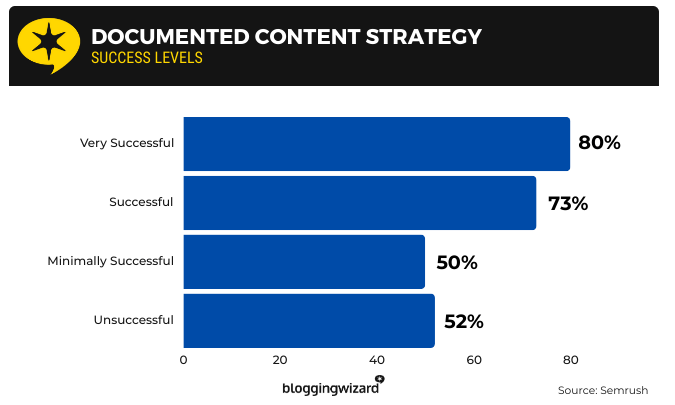
(Source – Blogging Wizard and Semrush)
Before you begin building your content strategy, please download the content strategy template.
Document Your Baseline Information
Now that the content strategy template has been downloaded, you can begin documenting your information. The first thing you should document is your business objectives and business goals.
Define and Document Your Business Objectives and Business Goals
Every piece of content needs a purpose. Your content goals should align with specific business objectives and goals, such as:
- Building brand awareness
- Generating qualified leads
- Establishing thought leadership
- Improving customer retention
- Driving product adoption
Your business objectives and goals act as your guide to developing your content sufficiently. Without them, creating a strategy will be challenging because it lacks a clear focus and direction in relation to your goals and objectives. You don’t want a disconnect between your organization and your content.
Within the template, you can document your goals and objectives as shown below:

Aligning With Business Goals and Business Objectives
To keep things simple, when aligning objectives and content, start with your personal or company’s top 3-5 business objectives.
Setting SMART Content Goals and KPIs
Defining and clearly understanding your content goals and key performance indicators (KPIs) is another vital piece to developing a successful content strategy. Goals and KPIs serve as the foundation for your content strategy.
Establishing SMART Content Goals
The next item on your list is setting goals. Specifically, you should set SMART Goals.
SMART goals mean (Specific, Measurable, Achievable, Relevant, and Time-bound). More specifically:
- Specific: A clearly defined goal with no ambiguity or room for interpretation.
- Measurable: Quantifiable goals, so progress towards them can be tracked and measured.
- Achievable: A goal connected to an individual’s broader objectives and priorities. A goal has to be something you want to achieve.
- Relevant: A goal connected to an individual’s broader objectives and priorities. A goal has to be something you want to achieve.
- Time-bound: A goal with a specific deadline or timeline for completion. By following the SMART framework, individuals can create practical goals that are challenging yet achievable and aligned with their overall aspirations.
This helps avoid setting vague goals. Without specific parameters, it becomes difficult to determine whether you are succeeding.
Example SMART Content Goals:
- Increase organic blog traffic by 50% within 6 months
- Generate 100 qualified leads per month through gated content by Q2 2025
- Achieve a 25% email click-through rate on nurture sequences by year-end
- Reach 1,000 newsletter subscribers within 3 months
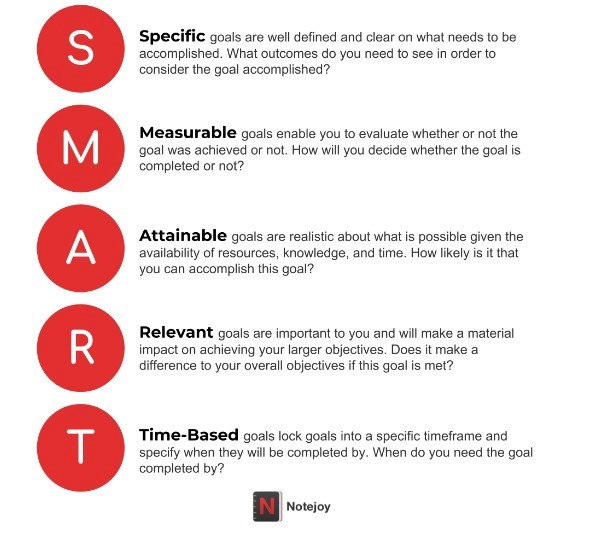
(Source – Notejoy)
Below is an example of how to enter your goals:

Metrics and KPIs Development
Now that you have developed your goals, it’s time to build key metrics to measure the performance of those goals for your content. Below is a list of metrics by category you should use. Remember that this isn’t an exhaustive list; you can use more than what’s outlined beneath.
Traffic Metrics
Traffic metrics measure how many people are visiting your website. Below is a list of key metric categories:
- Organic search visitors (broken down by landing page)
- Average time on page (minimum 3 minutes for long-form content)
- Bounce rate (aim for under 65% for blog content)
- Page scroll depth (target 75% scroll rate)
Engagement Metrics
Engagement metrics measure how many visitors interact with your website. Below is a list of key metric categories:
- Social shares per article
- Comments and discussions generated
- Email click-through rates
- Return visitor percentage
Conversion Metrics
The conversion metrics are another set of essential and valuable items to measure. Conversion metrics measure how well your content converts visitors to leads and customers. Key conversion metrics are as follows:
- Lead magnet download rates
- Newsletter signup conversion rate
- Demo/consultation request rate
- Content upgrade conversions
Creating a Content Scoring System
Once you’ve identified your metrics, you should create a scoring system as shown in the previous content strategy screenshot above. This will help you and your team understand whether your content’s KPIs are trending up, down, or showing no change.
Here is an example that can help.
Performance Score Component Examples:
- Traffic Performance (100 total points)
- Organic traffic (40 points)
- Social traffic (20 points)
- Direct/referral traffic (40 points)
- Engagement Quality (100 points)
- Time on page (25 points)
- Scroll depth (25 points)
- Social shares (25 points)
- Comments (25 points)
- Conversion Impact (100 points)
- Lead generation (85 points)
- Email signups (10 points)
- Sales attribution (5 points)
Important Note – You can create your own point scaling system with criteria specific to your goals.
Voice and Tone Development
Having a consistent voice and tone, no matter what your content is, is extremely important. Consistent content in voice and tone generally has a higher probability of building repeat viewers and customers. Below are some items to keep in mind when figuring out your voice and tone.
Voice Characteristics
- Formality level (scale of 1-5)
- Technical depth
- Emotional resonance
- Cultural alignment
Tone Guidelines
Develop specific guidelines for:
- Headlines and subheadings
- Body Content
- Call-to-actions
- Email communications
- Social media posts
It’s important to remember that your goals, metrics, and customer personas need to be reviewed periodically. Gaining new data and insights into your content will help you stay updated with your customer’s pain points. The most successful content strategies are those that take into account their customer’s evolving challenges.
Define and Document Your Target Audience and Personas
Your content strategy starts and ends with your audience. Your audience is just as important as your business objectives and goals. To understand your customers, you should build a customer persona.

You should know as much as possible when trying to understand your customers. Many aspects are key, including the following:
- Demographic Information
- Age
- Location
- Education
- Job Title
- Industry
- Psychographic Information
- Goals and Objectives
- Values
- Pain points and challenges they’re facing
There are many other criteria you can use that are not listed in the customer persona displayed, including:
- Questions they’re asking online
- Preferred content formats (video, text, audio)
- Level of expertise in your subject matter
To have your customer persona in a central place, you can also document it in the customer template as shown below:

Document Your Resource Inventory
A documented inventory of your content resources is also vital to the success of your content strategy. You need to be mindful of all of the resources that go into content, and they need to be reviewed, maintained, and updated when necessary.
People and Teams Assessment
The first set of resources that need to be documented is your teammates. They are the most critical aspect of your content; without them, there is no content.
People Skills Matrix
Documenting your team members and noting their skills is vital. This is because different types of content may require different skill sets. Depending on the type, understanding people’s various skills will help you develop more content. For example, you’ll need different skill sets for someone writing a how-to guide versus a script for an educational video.
Some of the most critical skill sets to track are as follows:
- Content writing expertise
- SEO knowledge
- Design capabilities
- Video production skills
- Project management experience
- Subject matter expertise

Capacity Analysis
Once you have documented the contributors’ skill sets, you should document their availability. Documenting key availability items such as time spent on meetings, execution, and available hours per person will help ensure you are aligned with the output you expect based on the time allotted per project.
- Available hours per team member
- Project overlap considerations
- Time spent on meetings vs. execution
- Buffer for unexpected tasks
- Vacation and time-off impacts

Technology and Tools Inventory
Tools and technology are vital areas to inventory. Keeping track of them will help you better understand what you use for each content item. For example, you may leverage an SEO research platform like Ahrefs for a how-to guide on SEO.
Content Creation Tools
Content creation tools help you develop and manage your content. You’ll use at least one content creation tool to help build your content.
An example of tools to keep an inventory of is as follows:
- Content Management Systems
- SEO research platforms
- Design software
- Video editing tools
- Project management systems
- Analytics platforms

Distribution Channel Documentation
Your content strategy must identify which channels make the most sense for reaching your audience. List the distribution channels you’ll leverage for your content.
Budget Documentation
Knowing what you’re spending is just as important as the content you’re developing. You don’t want to overspend on the people or tools you use to bring your content to life.

Cost Categories
Budgetary information should include contributor salaries (employees, contractor freelancers) and software subscriptions.
Try to break down the budget into:
- Team salaries and benefits
- Freelancer/contractor costs
- Software subscriptions
- Content promotion budget
- Training and development
- Content distribution costs
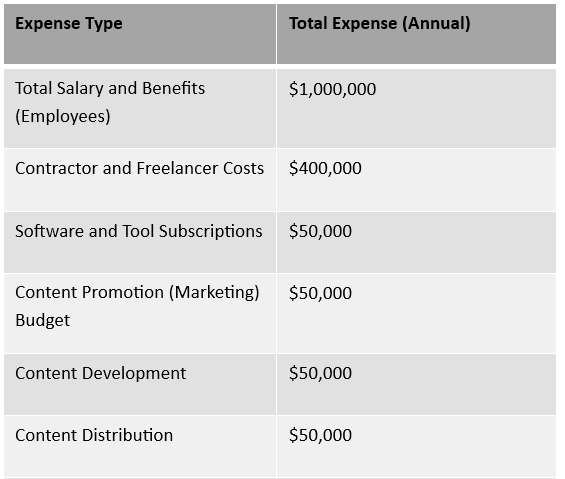
ROI Tracking
Keeping track of your return on every significant investment should be performed. You want to ensure your team’s efforts meet your organization’s standards and reach their business objectives and goals.
- Cost per piece of content
- Revenue generated per content type
- Customer acquisition costs
- The lifetime value of content-generated leads

Time Allocation Documentation
Knowing where you are putting your time helps you understand what it takes to complete assignments and what goes into them.
Project Time Mapping Analysis
Mapping where your time goes on each piece of content you create helps you get an overall picture of how your projects are going. Below is an example of how to track your time.
Detail your time-tracking as displayed:
- Content planning (15% of the time)
- Creation and editing (40%)
- Review and approval (20%)
- Distribution and promotion (15%)
- Analysis and optimization (10%)
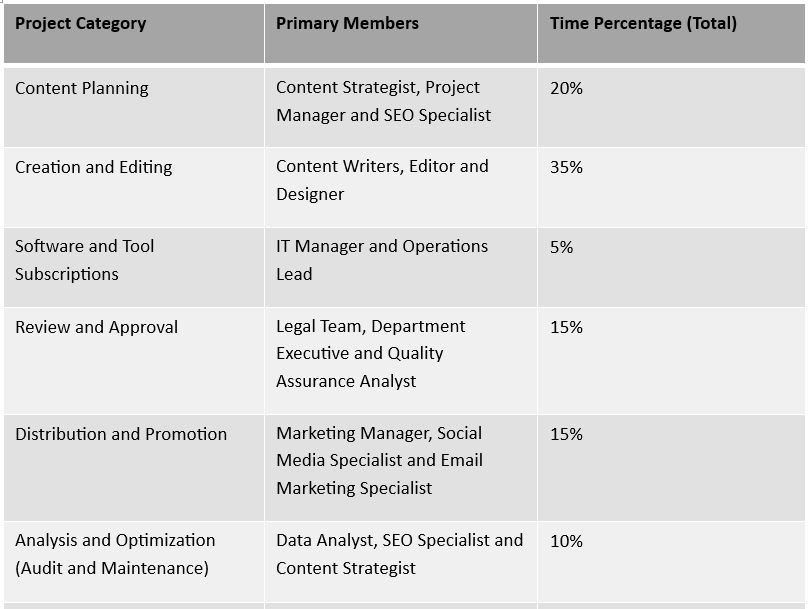
Constraints Analysis
Learning where your pain points are will help you understand what you need to work on to improve your content development process and time management. Your constraints generally affect people and processes.
Member Constraints
- Skill gaps in the team
- Limited availability of SMEs
- Training needs
- Communication bottlenecks
- Technical expertise shortages
- Product Efficiency
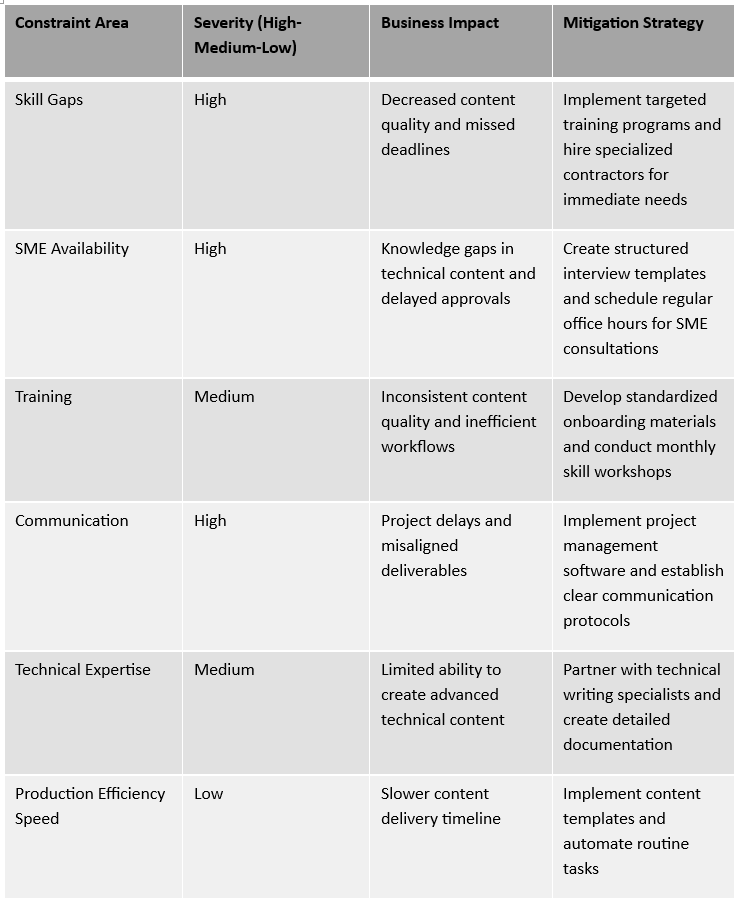
Process Constraints
- Approval workflow issues
- Quality control challenges
- Tool adoption barriers
- Cross-department coordination

Remember, documenting constraints isn’t about making excuses; it’s about being realistic about what you have and can achieve. It’s vital to identify areas for improvement. Try reviewing documentation and updating it quarterly to track progress and adjust strategies based on any deviations.
Conducting a Content Audit and Analysis
One thing to understand is that a content audit isn’t just an initial pass at your blog posts, articles, and videos. An audit is an extensive review of your content. It is among the most important tasks you will perform when developing a successful content strategy. Below is a detailed process of how to successfully audit your content:
Creating Your Content Inventory
First, let’s get organized. Documenting your content is essential; you must keep a complete record to audit it properly. You can document the metrics as follows:
- URL and page title
- Content type (blog, whitepaper, video, etc.)
- Publication date
- Last updated date
- Word count
- Primary topic/category
- Target persona
- Customer journey stage

Performance Metrics
Analyzing performance will help you understand your content. When reviewing your content, try categorizing your content into a couple of different categories. Try some of these:
- High Performing Content: Content that is performing well and perhaps better than your goals in terms of traffic and conversions.
- Hidden Potential Content: Content performing well (average) but could do better with updates.
- Underperforming Content: Content that is currently getting little to no traffic.
- Outdated and Irrelevant Content: Content that needs to be removed or redirected to your content that is performing better.
Having your content categorized will help you figure out which content you should prioritize with addressing.

Content Quality Assessment
The quality of your documentation is vital to its success. When assessing the quality of each piece of content, try using any of the following indicators to help determine its quality.
Quality Indicators
- Accuracy of information
- Depth of coverage
- Writing clarity
- Visual appeal
- Mobile responsiveness
- Call-to-action effectiveness
- Internal linking structure
One of my biggest learnings is that outdated content is almost as bad as having no content. I typically flag any piece that’s:
- Over 18 months old without updates
- Contains outdated statistics
- References obsolete tools or methods
- Has broken links or images
Try to use a scoring system from 1-5 (1 being bad and 5 being excellent) for each piece of content. See the template example below:

Gap Analysis Framework
Sometimes, your most significant opportunities are what you haven’t published yet. Leverage a tool like Google Keyword Planner, Ahrefs or Semrush to perform a content gap analysis with your competitors. Once complete, document them accordingly. There are many key items to document when it comes to performing a Gap analysis, as shown below:
- Content types they produce
- Publishing frequency
- Average content length
- Keyword
- Keyword Type
- Engagement metrics (when available)
- Content distribution channels

Action Plan Development
Once you have analyzed your content and the metrics behind it, you must develop a clear plan to guide you moving forward. Try to categorize your content into actionable tasks. Use the content categories noted below:
- No Change– Keep content as is.
- Update and Optimize – Update your content and optimize it for SEO.
- Consolidate with Other Existing Content—Move content into better-performing content that is similar and makes sense to the content. You may consolidate it with other content to improve both.
- Delete and Redirect – Delete the content and redirect links to content that performs better or can be improved with additional updates.
- Create New Content to Fill Gaps – You can create a brand in new areas needing assistance.
Below is an example of how to use this with the template:

Conclusion
A well-structured content strategy is your roadmap to success. By following this template and customizing it to your needs, you’ll be well-equipped to create content that drives actual business results. Keep in mind, the key is to remain flexible and optimize your approach based on performance data and audience feedback.